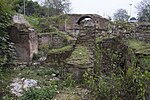İskender Pasha Mosque, Fatih
İskender Pasha Mosque (Turkish: İskender Paşa Cami), a.k.a. Terkim Masjid (Turkish: Terkim Mescidi) is a historic mosque located in Fatih district in Istanbul, Turkey.Located on Sarıgüzel Street in İskenderpaşa neighborhood of Fatih, it was endowed in 1505–06 by İskender Pasha, who lived at the time of Mehmed the Conqueror (1432–1481) and served as a vizier of Bayezid II (reigned 1481–1512). A native of Çakallı village of Vize, İskender Pasha died in 1507, so it is assumed that the mosque was built at the end of the 15th century or in the beginning of the 16th century. The mosque takes its other name "Terkim Masjid" from the Janissary barracks situated in the vicinity in the past.The mosque was repaired and restored in the years 1756, 1887, 1945 and 1956. In 1989, a two-story annex of 360 m2 (3,900 sq ft) was added to enlarge the prayer room. The 1999 İzmit earthquake, caused the spire of the minaret fell onto the main dome and caused considerable damage. The mosque underwent major repair and restoration works in 2006.
Excerpt from the Wikipedia article İskender Pasha Mosque, Fatih (License: CC BY-SA 3.0, Authors).İskender Pasha Mosque, Fatih
Sangüzel Caddesi, Istanbul
Geographical coordinates (GPS) Address Nearby Places Show on map
Geographical coordinates (GPS)
| Latitude | Longitude |
|---|---|
| N 41.01667 ° | E 28.94788 ° |
Address
İskender Paşa Camii
Sangüzel Caddesi
34080 Istanbul
Türkiye
Open on Google Maps








